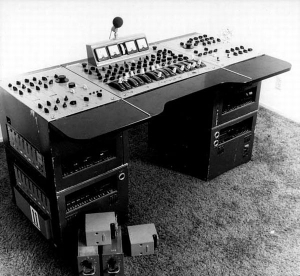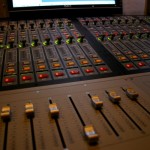
Confessions of a Plug-In Junkie

This is kind of following the same thread I started a couple weeks ago talking about my tools. I’ll freely admit I use a lot of plugins. In fact, I probably rely on them as my primary source of signal processing when mixing. I’ve been seeing plugins get a lot of flack lately which is bizarre to me so I figured I’d take a couple of minutes to talk about why I use plugins and what I use them for.
First, a brief history lesson. In the analog days of yore when recording engineers wore lab-coats, engineers used plugins. That’s right. Plugins. The photo you see here is one example. The console here is one of EMI’s REDD consoles and the modules on the floor next to the console are plugins. You see, back in the days when almost famous artists like The Beatles were recording, if an engineer wanted to process a signal in a particular way, he would take a module like one of these and literally plug it in to the console. Hence the term plugins.
As technology progressed, console manufacturers started adding signal processing directly into the console. However, over time the engineers still wanted more or even just different types of processing. The solution was to fill these big things called racks with specialized equipment in order to process their signals. As different manufacturers marketed different pieces of gear, engineers discovered some pieces of gear worked better on certain instruments than others. For example, compressor A might bring the drums to life while compressor B might add magical qualities to a vocal. Over time, engineers would customize their racks with their favorite gear.
Enter the dawn of the digital console era we are in today where it’s very common that a digital console comes stock with a myriad of bells and whistles granting the ability to process signals in ways that could only be done using those big rack of yore. For many engineers this has been reason to rejoice because now they actually have more processing available to them than ever before. Some even wonder why they would ever need more than a console has to offer.
But there’s an issue in this that is often ignored. Onboard processing built in to consoles is generally all the same. Most consoles might have one or two compressor types and maybe one type of EQ. And those types aren’t always the best way to process some things.
For some reason when it comes to signal processing these days, many of us ignore that different things work better on different sources. We pick different mics for things for exactly this reason. Why would we expect things to be different when it comes processing our signals?
Using the same processor on everything is like painting every room in your house the exact same color. Sure you can do it, but why would you want to if you didn’t have to? It’s pretty boring and unimaginative. Or here’s another way to look at it. Would you take your car over to the tire shop to have engine work done? The mechanics there might be able to do the work, but do you really want the guy who spends the bulk of his time changing tires to open up your engine?
So I use plugins for several reasons, but here are a couple of the main ones:
– Plugins offer me a wider variety of processing to tailor the processor to what works best for the instrument
– Plugins often sound better than the stock processing that comes on a console
For example, I am a big fan of the stuff Waves is making these days and recently joined their artist roster because of this. There’s just something about the CLA-76 on a snare drum that I can’t get using the onboard channel comp on my console. I could make a mix happen without the CLA-76, but that plugin just brings something else to the table. I’ve also been using the Renaissance Channel plugin for EQ and compression on my vocals lately. I’ve been really happy with the RVox compression curve in the plugin, and I find myself using less EQ with the plugin. I also feel like the top end is smoother compared to the onboard EQ.
Do I need plugins to mix? Of course not. In fact, in a perfect mix scenario I would just put the faders up and balance them and everything would sound amazing. Unfortunately, it’s very rare that I don’t need to apply some sort of signal processing somewhere in the mix. When I do need to reach for a signal processor, I want to pick the best tool for the job. I want something that sounds best to my ears and gets me the results I want quickly. Sometimes that means using onboard stuff, but oftentimes that means using a plugin.
Let me wrap this up by saying something about processing in general. Just because you have access to something doesn’t mean you should use it. One of the things I hear people blame plugins for is their overuse. That’s not a problem with plugins; that’s a problem with people! This is nothing new in audio world. Many engineers fall into the trap of using things and turning things on just because they can. I get that. I like blinking lights, too. But it doesn’t matter if it’s rack gear, onboard processors on a console, or plugins; the same temptation and problem exists.
If you want to get a taste of what plugins can do for a mix and pick up some tips along the way, check out the webinar my friend Zito recently did for Waves on mixing vocals; Zito’s a great expert for this because he’s done a lot of mixing for artists where the vocals are critical such as Babyface and the Backstreet Boys. In the webinar Zito uses real examples and goes into great depth on how he mixes vocals and why he chooses the processors he uses. It’s a great watch even if you’re not interested in plugins.

 Previous Post
Previous Post Next Post
Next Post


